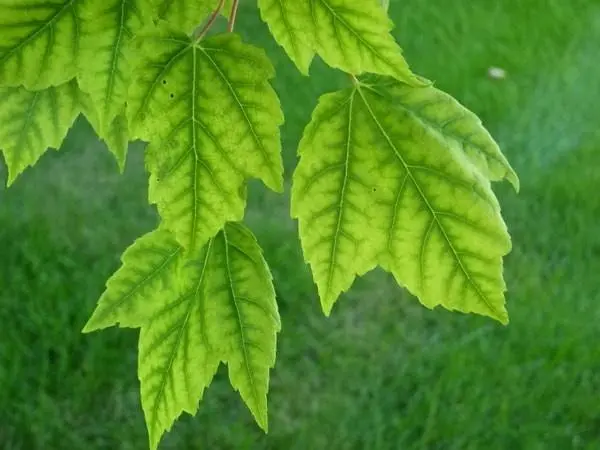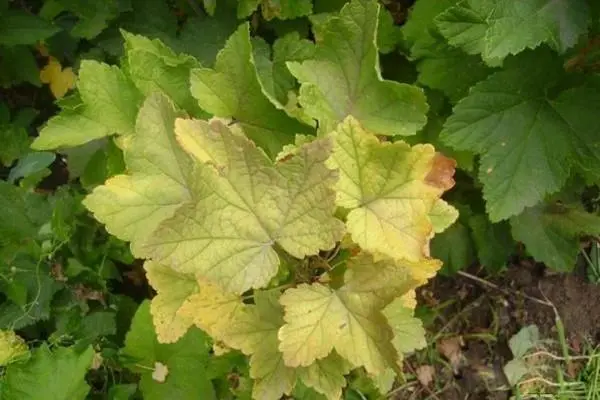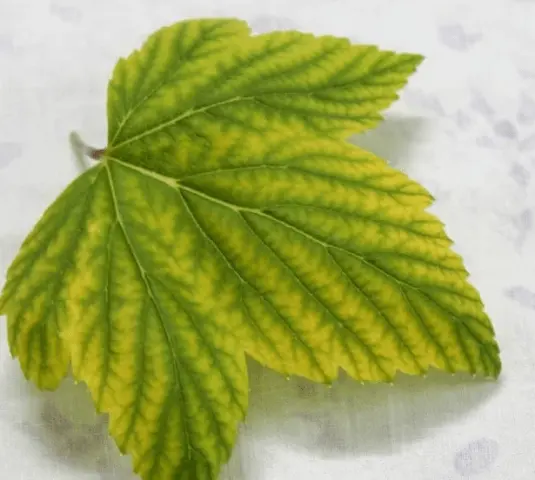Contents
Currant leaf chlorosis is a complex of diseases, the causes of which may be associated with infections or metabolic disorders. As a rule, pathology occurs due to improper care, when plants clearly lack nitrogen, iron, magnesium or other elements. For treatment, several top dressings are used. Moreover, it is better to use not complex, but highly specialized compositions. It is allowed to use folk remedies.
Causes of currant chlorosis
There are two types of chlorosis – infectious and non-infectious. The first is associated with exposure to fungi, viruses, bacteria and other pathogens. This is a dangerous disease that quickly infects currant bushes and neighboring plants.
Non-infectious chlorosis is associated with a lack of nutrients, such as nitrogen, phosphorus or potassium. Its main reasons are:
- infertile, depleted soil;
- root damage;
- unbalanced fertilizer application (lack or excess, irregular feeding);
- increased soil moisture;
- lack of stones, sand and other drainage;
- too acidic or, conversely, alkaline environment.
Thus, currant bushes suffer from chlorosis due to improper care.
Symptoms of occurrence
Chlorosis of currants and other plants is quite easy to determine visually. The disease is always accompanied by a change in the color of the leaf, and often the stems. They become yellow, purple, covered with spots. The main stages of development are:
- First, currant leaves lose their classic bright green color.
- They begin to turn yellow, become pale.
- Then brown, brown or purple spots may appear on them, depending on the specific type of chlorosis.
- Foliage and shoots of currant die off.
- Bushes lag behind in development, look weakened, bear fruit poorly.
Important! Throughout the season, chlorosis can develop cyclically.
For example, it disappears in the spring, and then appears in the summer, after which it disappears again by early autumn. Therefore, when the described symptoms appear, it is necessary to feed the bushes with fertilizers.

After some time, the symptoms of the disease disappear, and then reappear
To determine blackcurrant chlorosis, as in the photo, you need to know about the symptoms of a deficiency of one or another trace element:
- Iron chlorosis is more common than others. It is almost always observed on calcareous soils with an alkaline reaction. It manifests itself as a uniform yellowing of the entire leaf plate, with the exception of the veins, which remain green.

- Magnesium – most often develops on light soils – sandy and sandy. It looks like iron chlorosis, while the color of the currant leaf changes not only to yellow, but also to red or orange. First, the old foliage is affected, then the young.

- Sulfur occurs on soils with high acidity. Young currant leaves turn yellow, and the process begins with the veins.

- Nitrogen – white or yellow streaks appear on the leaves. The provoking factor is acidified soil. Eliminate nitrogen deficiency should be as soon as possible, because because of this type of chlorosis, currants grow slowly, which will affect the yield.
- Zinc – orange or yellow spots appear on old currant leaves. At the same time, signs of nitrogen chlorosis are often observed.
- Calcium – a rare variety, leads to yellowing of foliage over the entire area. As a result, the ovaries stop growing and fall off, rot appears on the currant berries. Often the disease appears in conditions of sandy soil.

What is dangerous chlorosis
Any kind of chlorosis poses a serious threat to currants. Due to the development of the disease, the natural metabolic processes in the plant, including photosynthesis, are disrupted. Because of this, the foliage dies off, falls off, the shrub slowly fades.
Initially, young shoots and leaves suffer, then the disease spreads to old ones. In this case, the ovaries fall off, which adversely affects the yield. Even if the currant berries form, they will be small, with an irregular shape. Often they ripen with a delay.
Another dangerous consequence of chlorosis is a weakened immune system, which can cause the bush to suffer from diseases and pests. In addition, winter hardiness decreases, the plant may die during severe frosts or against the background of temperature changes.
How to deal with chlorosis of black and red currant leaves
The fight against chlorosis of black and other types of currants is carried out by various means. The most effective option is to use ready-made complex fertilizers with a balanced composition. You can also use folk remedies. In order to prevent the development of currant chlorosis, it is important to carry out basic agrotechnical measures (pruning, loosening, preventive treatments, and others).
Chemicals
Chlorosis can be quickly eliminated with the help of chemicals. It is best not to use organics and complex compounds, since they can only accelerate the development of pathologies. Fertilizers should be used that contain exactly the right trace elements, for example:
- “Agricola”.
- “Iron chelate”.
- Ferovit.
- “Ferrylene”
“Agricola” is a powder, which includes nitrogen, phosphorus and potassium (approximate ratio 1:1:2), as well as various trace elements. For the treatment of currant chlorosis, it should be applied according to the instructions. First, the powder is dissolved in water, and then watered under the root.
The tool not only enriches the soil with nutrients, but also stimulates the ripening of the crop. The drug is applied twice per season – in early and mid-spring with an interval of 2-3 weeks.
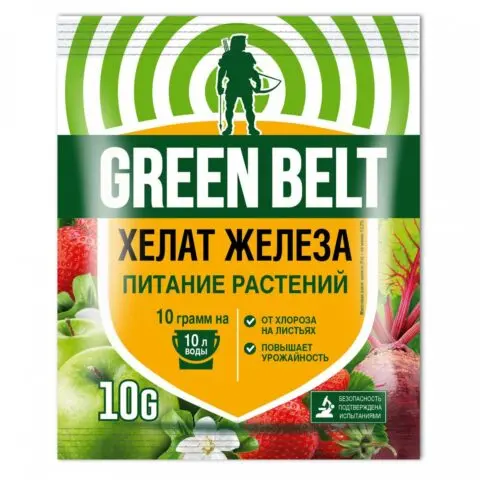
“Iron chelate” is used to treat iron chlorosis
Antichlorosin is produced as a solution of 10% concentration. It is used both for watering the soil and for processing plants. At the same time, the introduction into the soil is more efficient. During the season, up to three sprayings are carried out with an interval of two weeks. For each adult currant bush, up to 25 liters of working solution are spent.
Ferovit is a complex tool for eliminating iron deficiency in the soil. It is the same iron chelate, but here the composition differs in the presence of nitrogen compounds. Apply in any month of the season, including shortly before harvesting. Does not affect the taste of currant berries.
“Ferrilen” – chelated iron, is used to prevent currant chlorosis. The standard dosage is 1 g per 2 liters of water. The drug must be stored in a dark place, because under the action of sunlight, organic complexes are quickly destroyed.
Folk methods
Also, for the treatment and prevention of currant chlorosis, you can use folk remedies:
- Tobacco dust, which is used against pests, contains a lot of magnesium, iron and phosphorus. It is insisted in water and sprayed.
- Wood ash contains a rich complex of phosphorus, potassium and trace elements. For processing, it is insisted in water and sprayed on the bushes. Also, the powder can be patched up when planting.
- Water after washing the cereals is a prophylactic against chlorosis. It does not contain many valuable elements, therefore it is used undiluted.
- Onion decoction – 50 g of husk per 10 liters of water. The liquid is boiled for 5 minutes and infused for three hours. Use for both irrigation and foliar treatments.
Agrotechnical events
Agrotechnical measures also help in the fight against chlorosis. First of all, you need to carefully choose a place for planting currants. It should be sunny and protected from winds, as well as from stagnant rain and melt water.
To avoid chlorosis, currant seedlings should be planted on light, fertile soil with a loose structure. Loam with a slightly acidic or neutral pH of 5,5 to 7,0 is optimal.
In the process of growing, it is very important to periodically prune – in early spring or late autumn. The soil is loosened so that the roots have constant access to oxygen. Deformed and dried ovaries are pinched as necessary.
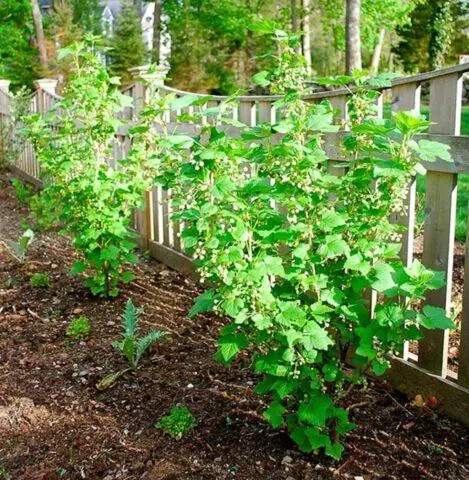
If you regularly fertilize, the bushes will please you with a high yield.
preventive measures
It is always easier to prevent currant chlorosis than to eliminate its consequences. For prevention purposes, the following measures are recommended:
- In the spring, the bushes are treated with Bordeaux liquid or other preparations.
- Currants are fed regularly. In the spring, nitrogen compositions are given, during the budding period, the emphasis is on superphosphate and potassium sulfate.
- Do not add organic matter in excess.
- In the autumn, the near-trunk circle will be sure to be cleaned of fallen leaves and other plant residues.
- For the winter in frosty regions, shelter is sure to be made. The trunk circle is mulched with straw, hay, peat and other materials. Branches after pruning are tied in groups of 3-4 pieces, and then laid on a “pillow”. Top covered with dense agrofibre.
Conclusion
Currant leaf chlorosis is quite dangerous, since a chronic deficiency of one or another element can lead to the death of the shrub. Infectious forms of the disease also carry serious risks – the pathology can spread to neighboring plants. Therefore, when the first signs of chlorosis are detected, it is necessary to immediately establish the cause and treat it with the appropriate drug.










